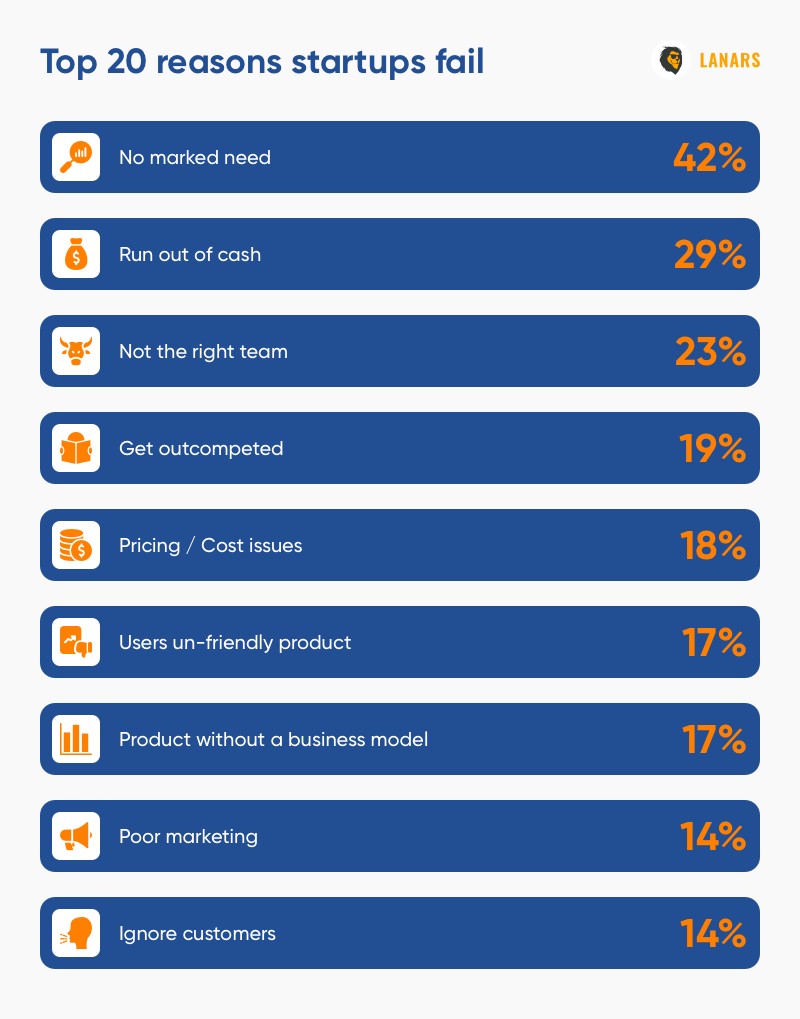Look at the graph below. The information comes from CB Insights’ report on start-up failures, which was released at the end of 2019:
The good news is that blunders like this can be avoided. To evaluate the genuine value of your product, you must first learn about your target audience, rivals, and the industry. The market research process for a company should not be overly complicated or expensive. Only after conducting market research can a meaningful business plan be produced, as it determines the project’s direction and tone.

Image cred: Larnars
How to do market research?
Before digging deeper into your market, target audience, and competitors, it’s a good idea to refresh your memory on the different types of research methods available: primary research and secondary research.
Primary market research
The internet can only tell you so much. Some information will have to be obtained directly from the source, such as your target audience. This is where primary data comes into play. This is research that you conduct on your own, gathering information directly from the people who will be using your product or service. A great way to do this is to conduct online surveys or focus groups to gain a thorough understanding of what your future buyers and loyal customers require.
Secondary research
When you use existing research and data, you are conducting secondary market research and gathering secondary data. This can be useful for investigating market dynamics and detecting trends, such as with Google Trends. Secondary data is, of course, extremely useful, but because it is based on outside research that was not conducted with your company in mind, it will always lack that critical link back to your offering.
The following are examples of questions that can be addressed through secondary research:
- What are the current economic conditions, and are they changing?
- What are the industry trends?
- Are there international markets for my product or service?
- Who are my customers? (Population, age group, income levels, where they live, etc.)
- What is the state of the labour market?
The 5 Step-by-Step Guide on Conducting Market Research for Start-ups:
- Determine the goal of market research
Before you get ready to put in the time and effort required by market research, figure out why you’re doing it. What issue did you hope to solve through research? What will be done with the findings? Is it something you’ll do internally or something you’ll do externally?These are some of the questions to which you should have responses on hand while performing market research. When these questions are answered, the market research becomes more direct and credible - Select the most appropriate research methodology
The two most common approaches for conducting market research have already been discussed. You must choose one. So, take some time to consider the advantages and risks disadvantage of both methods before deciding, as you won’t be able to move further without it. - Know the target market well
After determining the reason for conducting market research, the next stage is to gain a thorough understanding of the market. There are a variety of trustworthy research methods available for this.We recommend getting the advice of industry experts, reading relevant market reports, and keeping an eye on market trends to get the necessary knowledge of the target market. - Ask, ‘what is crucial?’
If the correct questions are asked, one can make the most of their market research efforts. You can obtain useful facts and aim in the proper direction by asking essential questions.The following are some crucial questions to include in a strong market research strategy:
• Who all are your direct and indirect competitors, and what’s their market worth?
• What feature can make my service stand out?
• What’s the scope of my service/product in the target market?
• What are current trends in the market?
• How is the buying behavior of the customers in your target market?Including all these questions in your research will make it worthwhile. Don’t limit yourself to these questions. If you choose to conduct primary research, you have complete freedom to create question templates that are 100 percent accurate. Simply conduct a thorough investigation to determine what information you require and formulate questions accordingly. - Gather Insights and Determine Action Items
After you’ve categorized your data, you’ll need to analyze it to get useful information. While some of the data will be qualitative rather than quantitative, trends in responses can be detected to make it quantitative. For example, 15 out of 20 respondents said they felt overwhelmed while attempting to assemble your product.Outline action items after you’ve analyzed the data and discussed emergent themes.For example: If most users in your target demographic were overwhelmed when putting together your product, take the following steps:
Creating many versions of assembly instructions to test with different groups, including different diagrams and instructional language
Research instruction manual best practices
Each round of market research can provide greater insight into how potential customers view and use your product.
Market research is one of the most critical things you can invest in because the appropriate market insights may make or break your organization. Don’t leave market research to chance; instead, select the best tools to put your start-up on the right track.




